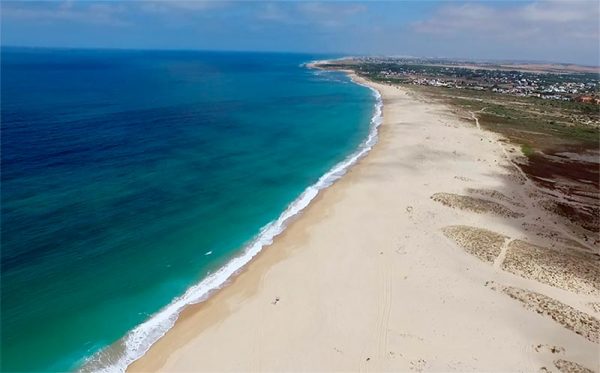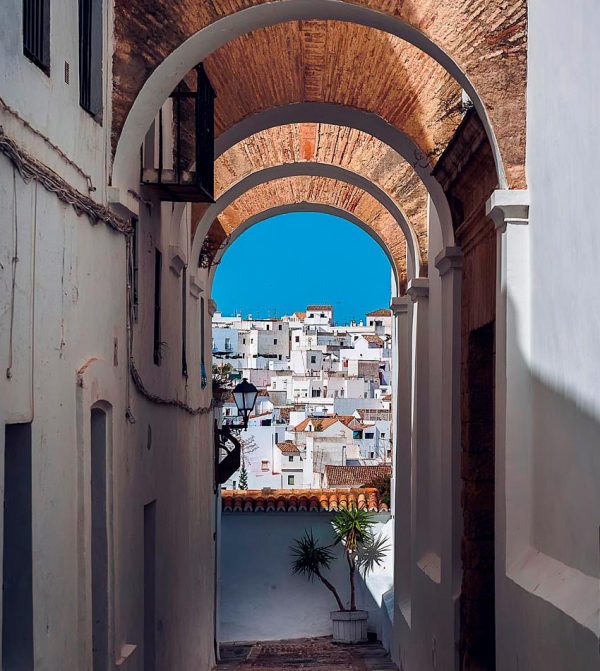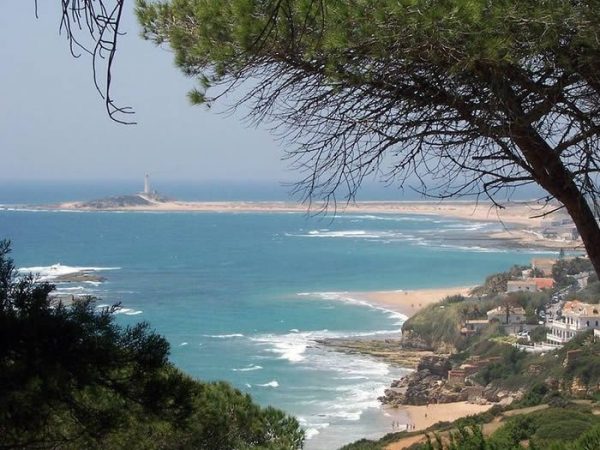Costa de la Luz
It has one of the largest stretches of coastline, with more than 200 kms of wonderful beaches of golden and fine sand open to the Atlantic Ocean. Its name comes from the intense light that highlights the neatness of the streets, the liming of the walls, the gold of the dunes and the reflection of the sea. The coast is dotted with coastal towns where you can enjoy a cuisine based on fish and seafood: Sanlúcar de Barrameda, also famous for its horse races on the beach, Rota, Chipiona, Conil de la Frontera, El Puerto de Santa María and Chiclana de la Frontera.
The beach of El Palmar
You can enjoy a wide and beautiful beach where you can see beautiful sunsets and sunsets. The campsite is 900m from the beach. Beach of fine white sand, conducive to surfing and other sports, including fishing. The beach has a lifeguard service in summer and you can also find several surf schools offering classes or equipment rental.
Los Caños de Meca – Zahora
Located 2 km south of El Palmar, Los Caños de Meca is an eminently tourist town centered on its good and varied beaches, some of which are nudists, which extend from Cape Trafalgar to the cliffs of La Breña. The cape is protected within the Natural Monument of Tómbolo de Trafalgar, while the cliffs are part of the Natural Park of La Breña and Marismas de Barbate, together with the pine forest that covers its upper part and a maritime strip. From the population center to the cliffs, the famous canals that give the area its name appear. These are freshwater springs in the cliff wall of different flow, from small humidities in the rocky wall to important springs, which vary greatly depending on the season and the rainy season. The most important, the Caño Grande, is located near the end of the cliff area, with very complicated access and only at low tide.






White Villages
The Sierra de Cádiz, with an abundant archaeological heritage, extends to the north of the province in an abrupt, tasty, green and exciting route: the Route of the White Villages. Arcos de la Frontera, declared a historic-artistic monument is one of the most famous white villages. It is followed by Ubrique, El Bosque and Prado del Rey, known not only for the beauty of its landscapes, but also for its craftsmanship. Algar, Algodonales, El Gastor, Puerto Serrano and Villaluenga del Rosario are part of the Route. Also Benaocaz, Bornos, Espera, Villamartín and Olvera, each one with its parties, its castles and its peculiarities. The route goes into the Grazalema Natural Park, declared a Biosphere Reserve, where we can not miss the town of the same name, as well as Zahara de la Sierra, with one of the most spectacular landscapes in the area. Finally, Alcalá del Valle and Setenil de las Bodegas, with the unusual arrangement of their houses; excavated in the mountain, following the course of the river. Discover here the beauty of the region of White Villages / Sierra de Grazalema.
Vejer de la Frontera
Located in the region of La Janda, an old dried-up lake for agricultural use, this municipality has two distinct zones: the coast and the interior. Crossed by the river Barbate that forms an area of marshes, declared Natural Park and that are a redoubt of what was one of the most important wetlands in Europe. The town, which was part of the Christian frontier in the Nazari era, is located on a hill, from which a magnificent panorama is overlooked, and built around the Castle. The Urban Complex is of great beauty and attractiveness with its narrow and winding streets of well-kept white houses. In it you can highlight the Walls, the Church of the Divine Savior and the Arch of the Jewish Quarter.
Parque Natural de la Breña
Desde el entorno de Barbate a Caños de Meca y tierra adentro hasta Vejer de la Frontera se extiende uno de los parques naturales menos extensos de Andalucía con unas 5.000 hectáreas, el Parque Natural de la Breña y Marismas del Barbate. En él se distinguen hasta cinco ecosistemas diferentes: marino, acantilado, pinar, marismas y sistemas dunares. Destaca el impresionante Tajo de Barbate que, con más de 100 metros de altura, constituye el acantilado más notorio del Atlántico andaluz. Para contemplar de cerca este espectáculo y deleitar los sentidos, lo ideal es realizar un paseo en barco desde el puerto de Barbate por sus cristalinas aguas turquesas, en las que también se practican submarinismo y snorkel. Se distinguen en sus acantilados, aún erosionados por el agua y el viento, manantiales de agua potable que vierten en pequeñas caletas, son los conocidos caños. Junto a zarzas e higueras crecen plantas típicas de ambientes salinos como almajos, barrillas o siemprevivas. En los huecos de la piedra crían numerosas garcillas bueyeras, grajillas, y la gaviota patiamarilla, halcón peregrino, vuelvepiedras y zarapito trinador. Entre las rapaces, destacan el águila pescadora, la lechuza y el cernícalo vulgar. Los aficionados al parapente y ala-delta disponen en este espacio de lugares ideales para la práctica de estos deportes, incluso una escuela de vuelo libre en Vejer.
From the surroundings of Barbate to Caños de Meca and inland to Vejer de la Frontera, there is one of the least extensive natural parks in Andalusia with some 5,000 hectares, the Natural Park of La Breña and Marismas del Barbate. It distinguishes up to five different ecosystems: marine, cliff, pine, marshes and dune systems. Stresses the impressive Tajo de Barbate which, with more than 100 meters high, is the most notorious cliff of the Andalusian Atlantic.
To take a close look at this show and delight the senses, the ideal is to take a boat trip from the port of Barbate for its crystal-clear turquoise waters, where you can also practice scuba diving and snorkeling. They are distinguished in their cliffs, still eroded by water and wind, drinking water springs that pour into small coves, are the well-known pipes. Along with brambles and fig trees grow typical plants of saline environments such as almajos, barrillas or siemprevivas. In the hollows of the stone they breed numerous cattle egrets, jackdaws, and the yellow-legged gull, peregrine falcon, turnstone and whimbrel. Among the raptors, the osprey, the owl and the kestrel stand out. The paragliding and hang-gliding fans have in this space ideal places to practice these sports, including a free flight school in Vejer.
This biodiversity is multiplied in the marshes and lagoons, which shelter a large number of birds, as it is a nesting area and a migration point. A walk through its interior will allow us to photograph the mallard, coot, spoon duck, and even some small grebe, heron or imperial. Among the reed are small birds, bastard nightingales and common reed warblers.
Another characteristic landscape is the pine forest of La Breña. Its intense repopulation to stop the mobile dunes has turned it into the largest pine forest in Cádiz, from which pineapples and pine nuts are used. In this place, the aroma of pine is mixed with that of rosemary and lavender which, together with palmetto, black hawthorn and, even broom or mastic, form the existing Mediterranean scrub. The pine forest extends until skirting the cliff, where Aleppo pine coexists with juniper groves and abundant junipers.
It is best to go on horseback, highlighting the path of the Torre del Tajo that culminates in a beautiful panorama. This is one of the watchtowers that in the XV and XVI centuries alerted about pirate ships and that, later, witnessed the Battle of Trafalgar. But since the Phoenicians, the role of the sea was fundamental, with tuna fishing in trap and salting. Barbate is still a great fishing center, with its commercial port and great fondness for angling. Smooth and eels are caught in the estuary; and in the marsh, golden and floundering. In this way, the visitor will acquire on-site salted tuna products, mojama and cured roe.
White Villages
The Sierra de Cádiz, with an abundant archaeological heritage, extends to the north of the province in an abrupt, tasty, green and exciting route: the Route of the White Villages. Arcos de la Frontera, declared a historic-artistic monument is one of the most famous white villages. It is followed by Ubrique, El Bosque and Prado del Rey, known not only for the beauty of its landscapes, but also for its craftsmanship. Algar, Algodonales, El Gastor, Puerto Serrano and Villaluenga del Rosario are part of the Route. Also Benaocaz, Bornos, Espera, Villamartín and Olvera, each one with its parties, its castles and its peculiarities. The route goes into the Grazalema Natural Park, declared a Biosphere Reserve, where we can not miss the town of the same name, as well as Zahara de la Sierra, with one of the most spectacular landscapes in the area. Finally, Alcalá del Valle and Setenil de las Bodegas, with the unusual arrangement of their houses; excavated in the mountain, following the course of the river. Discover here the beauty of the region of White Villages / Sierra de Grazalema.
Vejer de la Frontera
Located in the region of La Janda, an old dried-up lake for agricultural use, this municipality has two distinct zones: the coast and the interior. Crossed by the river Barbate that forms an area of marshes, declared Natural Park and that are a redoubt of what was one of the most important wetlands in Europe. The town, which was part of the Christian frontier in the Nazari era, is located on a hill, from which a magnificent panorama is overlooked, and built around the Castle. The Urban Complex is of great beauty and attractiveness with its narrow and winding streets of well-kept white houses. In it you can highlight the Walls, the Church of the Divine Savior and the Arch of the Jewish Quarter.
Parque Natural de la Breña
Desde el entorno de Barbate a Caños de Meca y tierra adentro hasta Vejer de la Frontera se extiende uno de los parques naturales menos extensos de Andalucía con unas 5.000 hectáreas, el Parque Natural de la Breña y Marismas del Barbate. En él se distinguen hasta cinco ecosistemas diferentes: marino, acantilado, pinar, marismas y sistemas dunares. Destaca el impresionante Tajo de Barbate que, con más de 100 metros de altura, constituye el acantilado más notorio del Atlántico andaluz. Para contemplar de cerca este espectáculo y deleitar los sentidos, lo ideal es realizar un paseo en barco desde el puerto de Barbate por sus cristalinas aguas turquesas, en las que también se practican submarinismo y snorkel. Se distinguen en sus acantilados, aún erosionados por el agua y el viento, manantiales de agua potable que vierten en pequeñas caletas, son los conocidos caños. Junto a zarzas e higueras crecen plantas típicas de ambientes salinos como almajos, barrillas o siemprevivas. En los huecos de la piedra crían numerosas garcillas bueyeras, grajillas, y la gaviota patiamarilla, halcón peregrino, vuelvepiedras y zarapito trinador. Entre las rapaces, destacan el águila pescadora, la lechuza y el cernícalo vulgar. Los aficionados al parapente y ala-delta disponen en este espacio de lugares ideales para la práctica de estos deportes, incluso una escuela de vuelo libre en Vejer.
From the surroundings of Barbate to Caños de Meca and inland to Vejer de la Frontera, there is one of the least extensive natural parks in Andalusia with some 5,000 hectares, the Natural Park of La Breña and Marismas del Barbate. It distinguishes up to five different ecosystems: marine, cliff, pine, marshes and dune systems. Stresses the impressive Tajo de Barbate which, with more than 100 meters high, is the most notorious cliff of the Andalusian Atlantic.
To take a close look at this show and delight the senses, the ideal is to take a boat trip from the port of Barbate for its crystal-clear turquoise waters, where you can also practice scuba diving and snorkeling. They are distinguished in their cliffs, still eroded by water and wind, drinking water springs that pour into small coves, are the well-known pipes. Along with brambles and fig trees grow typical plants of saline environments such as almajos, barrillas or siemprevivas. In the hollows of the stone they breed numerous cattle egrets, jackdaws, and the yellow-legged gull, peregrine falcon, turnstone and whimbrel. Among the raptors, the osprey, the owl and the kestrel stand out. The paragliding and hang-gliding fans have in this space ideal places to practice these sports, including a free flight school in Vejer.
This biodiversity is multiplied in the marshes and lagoons, which shelter a large number of birds, as it is a nesting area and a migration point. A walk through its interior will allow us to photograph the mallard, coot, spoon duck, and even some small grebe, heron or imperial. Among the reed are small birds, bastard nightingales and common reed warblers.
Another characteristic landscape is the pine forest of La Breña. Its intense repopulation to stop the mobile dunes has turned it into the largest pine forest in Cádiz, from which pineapples and pine nuts are used. In this place, the aroma of pine is mixed with that of rosemary and lavender which, together with palmetto, black hawthorn and, even broom or mastic, form the existing Mediterranean scrub. The pine forest extends until skirting the cliff, where Aleppo pine coexists with juniper groves and abundant junipers.
It is best to go on horseback, highlighting the path of the Torre del Tajo that culminates in a beautiful panorama. This is one of the watchtowers that in the XV and XVI centuries alerted about pirate ships and that, later, witnessed the Battle of Trafalgar. But since the Phoenicians, the role of the sea was fundamental, with tuna fishing in trap and salting. Barbate is still a great fishing center, with its commercial port and great fondness for angling. Smooth and eels are caught in the estuary; and in the marsh, golden and floundering. In this way, the visitor will acquire on-site salted tuna products, mojama and cured roe.






